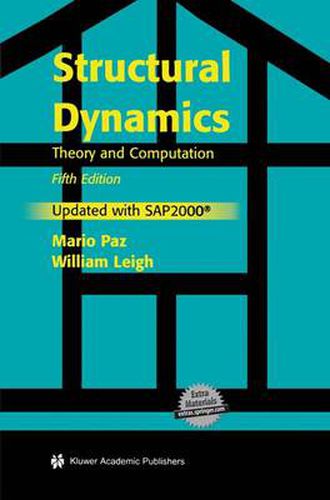Readings Newsletter
Become a Readings Member to make your shopping experience even easier.
Sign in or sign up for free!
You’re not far away from qualifying for FREE standard shipping within Australia
You’ve qualified for FREE standard shipping within Australia
The cart is loading…






This title is printed to order. This book may have been self-published. If so, we cannot guarantee the quality of the content. In the main most books will have gone through the editing process however some may not. We therefore suggest that you be aware of this before ordering this book. If in doubt check either the author or publisher’s details as we are unable to accept any returns unless they are faulty. Please contact us if you have any questions.
This fifth edition of Structural Dynamics: Theory and Computation is a complete and comprehensive text in the field. It presents modern methods of analysis and techniques adaptable to computer programming clearly and easily. The book is suitable to be used as a text for advanced undergraduates or graduate students taking a first course in structural dynamics. It is arranged in such a way that it can be used for a one- or two-semester course, or span the undergraduate and graduate levels. In addition, this text should serve the practicing engineer as a primary reference. The text differs from the standard approach of other presentations in which topics are ordered by their mathematical complexity. This text is organized by the type of structural modelling. The author simplifies the subject by presenting a single degree-of-freedom system in the first chapters, then moves to systems with many degrees-of-freedom in the following chapters. Finally, the text moves to applications of the first chapters and special topics in structural dynamics. New in this edition: problems reworked for SAP2000 TM; step-by-step examples of how to use SAP2000 TM for every application of structural dynamics; inclusion of a CD-ROM with three learning aids - SAP2000 TM student version; source code for the author’s educational programs in structural dynamics, so that the results of changed parameters can be seen step-by-step; and the compiler (executable files) for the author’s educational programs; three earthquake engineering chapters updated to the latest ICC TM building codes; material rearranged so that theory and dynamic analysis precede applications and special topics, facilitating using the book sequentially; and complete introductions provided to advanced topics as foundation for further study. This text is suitable for civil engineering students. Professional civil engineers should find it a handy reference.
$9.00 standard shipping within Australia
FREE standard shipping within Australia for orders over $100.00
Express & International shipping calculated at checkout
Stock availability can be subject to change without notice. We recommend calling the shop or contacting our online team to check availability of low stock items. Please see our Shopping Online page for more details.
This title is printed to order. This book may have been self-published. If so, we cannot guarantee the quality of the content. In the main most books will have gone through the editing process however some may not. We therefore suggest that you be aware of this before ordering this book. If in doubt check either the author or publisher’s details as we are unable to accept any returns unless they are faulty. Please contact us if you have any questions.
This fifth edition of Structural Dynamics: Theory and Computation is a complete and comprehensive text in the field. It presents modern methods of analysis and techniques adaptable to computer programming clearly and easily. The book is suitable to be used as a text for advanced undergraduates or graduate students taking a first course in structural dynamics. It is arranged in such a way that it can be used for a one- or two-semester course, or span the undergraduate and graduate levels. In addition, this text should serve the practicing engineer as a primary reference. The text differs from the standard approach of other presentations in which topics are ordered by their mathematical complexity. This text is organized by the type of structural modelling. The author simplifies the subject by presenting a single degree-of-freedom system in the first chapters, then moves to systems with many degrees-of-freedom in the following chapters. Finally, the text moves to applications of the first chapters and special topics in structural dynamics. New in this edition: problems reworked for SAP2000 TM; step-by-step examples of how to use SAP2000 TM for every application of structural dynamics; inclusion of a CD-ROM with three learning aids - SAP2000 TM student version; source code for the author’s educational programs in structural dynamics, so that the results of changed parameters can be seen step-by-step; and the compiler (executable files) for the author’s educational programs; three earthquake engineering chapters updated to the latest ICC TM building codes; material rearranged so that theory and dynamic analysis precede applications and special topics, facilitating using the book sequentially; and complete introductions provided to advanced topics as foundation for further study. This text is suitable for civil engineering students. Professional civil engineers should find it a handy reference.